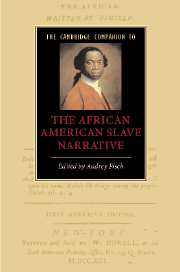Book contents
- Frontmatter
- Introduction
- Part I: The Slave Narrative and Transnational Abolitionism
- Part II: The Slave Narrative and Anglo-American Literary Traditions
- 5 Redeeming bondage: the captivity narrative and the spiritual autobiography in the African American slave narrative tradition
- 6 The slave narrative and the revolutionary tradition of American autobiography
- 7 The slave narrative and sentimental literature
- Part III: The Slave Narrative and the African American Literary Tradition
- Part IV: The Slave Narrative and the Politics of Knowledge
- Further Reading
- Index
5 - Redeeming bondage: the captivity narrative and the spiritual autobiography in the African American slave narrative tradition
from Part II: - The Slave Narrative and Anglo-American Literary Traditions
Published online by Cambridge University Press: 28 July 2007
- Frontmatter
- Introduction
- Part I: The Slave Narrative and Transnational Abolitionism
- Part II: The Slave Narrative and Anglo-American Literary Traditions
- 5 Redeeming bondage: the captivity narrative and the spiritual autobiography in the African American slave narrative tradition
- 6 The slave narrative and the revolutionary tradition of American autobiography
- 7 The slave narrative and sentimental literature
- Part III: The Slave Narrative and the African American Literary Tradition
- Part IV: The Slave Narrative and the Politics of Knowledge
- Further Reading
- Index
Summary
redeem (ri-'dEm) transitive verb.
1) To recover ownership of by paying a specified sum.
2) To set free; rescue or ransom.
3) To save from a state of sinfulness and its consequences.
4) To restore honor, worth, or reputation.
synonym See SAVE / In 1798 Venture Smith, the eldest son of an African prince, dictates the narrative of his life, A Narrative of the Life and Adventures of Venture, a Native of Africa: But Resident above Sixty Years in the United States of America. Related by Himself, to Elisha Niles, a Connecticut schoolmaster. Approximately ten years later, in 1810, itinerant preacher George White publishes the story of his life, appropriately titled: A Brief Account of the Life, Experiences, Travels and Gospel Labours of George White, an African; Written by Himself and Revised by a Friend. While the two narratives reflect vastly different experiences of bondage, both Smith's and White's autobiographical stories highlight acts of redemption: Smith and White consciously try to recover and restore what is lost and stolen from them by the institution of slavery. By charting the literary influence of the captivity narrative and spiritual autobiography tradition on Smith's and White's narratives, we can see a common rhetorical strategy both men employ: using conventional Anglo- American literary genres to tell unconventional African American stories. To fully understand the genre of slave narrative requires a familiarity with the other literary genres that have influenced the slave narrative form and that have also been transformed by the slave narrative tradition. In exploring the influence of the captivity narrative and the spiritual autobiography on these two texts, we can use Smith’s and White’s narratives to illuminate the literary interconnections that exist, on a lesser scale, in most all of the texts in the slave narrative tradition.
- Type
- Chapter
- Information
- Publisher: Cambridge University PressPrint publication year: 2007
- 4
- Cited by

